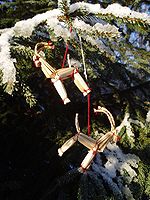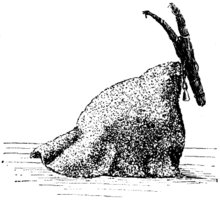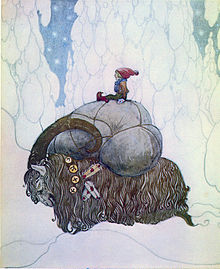- Yule Goat
-
 The Swedish Gävle Goat in 2006.
The Swedish Gävle Goat in 2006.
The Yule Goat is one of the oldest Scandinavian and Northern European Yule and Christmas symbols and traditions. Originally denoting the goat that was slaughtered during the Germanic pagan festival of Yule, "Yule Goat" now typically refers to a goat-figure made of straw.[1] It is also associated with the custom of wassailing, sometimes referred to as "going Yule Goat" in Scandinavia.
Contents
History
 A folk tale depiction of Father Christmas riding on a goat. Perhaps an evolved version of the Swedish Tomte.
A folk tale depiction of Father Christmas riding on a goat. Perhaps an evolved version of the Swedish Tomte.
Its origins might go as far back as to pre-Christian days, where goats were connected to the Norse god Thor, who rode the sky in a chariot drawn by two goats, Tanngrisnir and Tanngnjóstr, and carried his hammer Mjöllnir. The "Prose Edda", written by Snorri Sturluson in the 13th century, relates that when Thor kills and cooks the goats, their flesh provides sustenance for the god and his guests, and after Thor resurrects them with his hammer they are brought back to life the next day.
function of the Yule Goat has differed throughout the ages. In Finland, the Yule Goat was originally said to be an ugly creature that frightened children, and demanded gifts at Christmas. In Scandinavia, people thought of the Yule Goat as an invisible creature that would appear some time before Christmas to make sure that the Yule preparations were done right. During the 19th century its role shifted towards becoming the giver of Christmas gifts, in Finland as well as the rest of Scandinavia, with one of the men in the family dressing up as the Yule Goat.[2] The goat was replaced by jultomte or julenisse (Father Christmas/Santa Claus) at the end of the century, although he is still called the Yule Goat (Joulupukki) in Finland, and the tradition of the man-sized goat disappeared.
A Swedish custom that continued up to 1940–1960 in different parts of the country, was the Yule Sacrifice (Juleoffer) involving a person dressed as a goat which, after undergoing a mock-sacrifice, is resurrected. Sir James George Frazer described its performance as follows:
- The actor, hidden by a coverlet made of skins and wearing a pair of formidable horns, is led into the room by two men, who make believe to slaughter him, while they sing verses referring to the mantles of various colours, red, blue, white, and yellow, which they laid on him, one after the other. At the conclusion of the song, the Yule Goat, after feigning death, jumps up and skips about to the amusement of the spectators.[3]
The Yule Goat is nowadays best known as a Christmas ornament often made out of straw or roughly-hewn wood. In older Scandinavian society a popular prank was to place the Yule Goat in a neighbour's house without them noticing; the family successfully pranked had to get rid of it in the same way. The modern version of the Yule Goat figure is a decorative goat made out of straw and bound with red ribbons, a popular Christmas ornament often found under the Yule tree or Christmas tree. Large versions of this ornament are frequently erected in towns and cities around Christmas time – these goats tend to be illegally set on fire before Christmas. The Gävle goat was the first of these goats, and remains the most famous.
See also
Notes
References
- Frazer, James G. (1994). The Golden Bough: A Study in Magic and Religion. Oxford: Oxford University Press.
- Reade, Arthur (1919). Finland and the Finns. Dodd, Mead and Company.
- Rossel, Sven H.; Elbrönd-Bek, Bo (1996). Christmas in Scandinavia. Lincoln: University of Nebraska Press. ISBN 0-8032-3907-6
External links
- The Gävle Goat webcam
- A website with pictures of decorative straw goats
- The Gävle Goat has been fire proofed for Christmas 2006
- Traditional Christmas games
- Information about the Norwegian Yule Goat tradition
- Webcamplaza.net Christmas Cams
Categories:- Christmas traditions
- Christmas characters
- Scandinavian legendary creatures
- Scandinavian folklore
- Winter traditions
- Straw art
Wikimedia Foundation. 2010.



